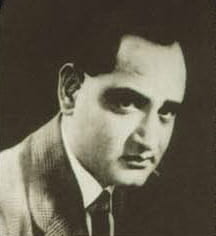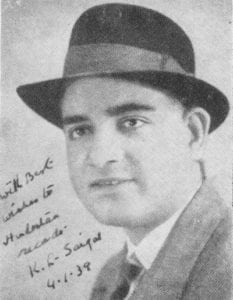Indian Music: Selective Discographies
(1904-47)
A short list of recordings
1] Saigal as a classical singer
1] Jhulana jhulao re – Dev Gandhar (Feb.1933) MP3 Excerpt
2] Main kya janun – Zindagi (1940)- Yaman
3] Do naina matware (My Sister, 1944) –Yaman
4] ]Dukhke din aab bitat nahin – Devdas (1935) – Des
5] Balam aayo baso more manmen – Devdas (1935) – Sindhura
6] Diya jalao jagmag jagmag – Tansen (1943) – Deepak
7] Sapta sur teen gram gao sub gunijan – Tansen (1943) – Dhrupad [based on a bandish of Alladiya khan]
8] Rumjhum rumjhum chal tehari – Tansen (1943) – Shankara
2] Saigal as a geet/ghazal singer
lakh sahi hum peeki batiya / laga gai chot / nuktachi hai game dil / Ye tasarruf allah allah / phir mujhe didaye tar (Galib)
3] Saigal sings in other languages
akhoni uthibe chand (Bengali) / O sohane sakiya, mahi naal je aankh (Punjabi) / marhabba gam ja (Des), rangin tar aajhun hasta [kawali-Madhuvanti], (Persian, pushto), song from Devdas dubbed in (Tamil)
4] Saigal as a bhajan singer
main nahi makhan khayo (Bhakta Surdas,1942) / suno suno he krishna kala – (Chandidas)
5] Saigal film songs around 1940
duniya rang rangoli baba – chorus – Panjak Malick, Uma Shashi and Saigal (Dharatimata, 1938) / Shahajahan (1946) – ae dile bekarar kyun (Bihag?) / chaha barbaad karegi (Bageshree) / gam diye mushtakil (Pilu) / jab dil hi toot gaya (Bhairavi)
6] Popular Saigal songs –
so ja rajkumari so ja (Zindagi, 1940) – Jhinjhoti
babul mora – (Street singer, 1938) – [Bhairavi]
Comp. by Nabab of Avadh, Wajid Ali Shah
Grateful acknowledgement is made to Suresh Chandvankar (Mumbai) for some of the above information. Any additional information, or corrections to the above, will be most welcome.
Kundan Lal Saigal (1904-1947)
A brief biographical account by
Suresh Chandvankar
Mr. Kundan Lal Saigal, popularly known as K. L. Saigal was the most popular actor-singer of the Indian films during 1935-47. Born on April 11, 1904 at Jullunder in Punjab, he entered in the films in 1931-32 and acted in about 40 films. He died on January 18, 1947 at the age of just forty-two. As a boy his mother used to take him to a Sufi-Pir Salman Yousuf of the Yesvi sect. Singing was his hobby. Later on he learnt music and basic melodic structures which he mastered through a lot of practice. He also learnt from some of the great masters of the period: Faiyyaz Khan, Pankaj Mullick and Pahari Sanyal.
His father was violently against his singing and was disappointed with his poor results at school. He left home and came to Calcutta. Before choosing music and singing as his vocation, he worked as a time-keeper in the Punjab Railways. He was a salesman for short time, selling typewriters. In those days, his singing was largely confined to a friend-circle. One such private concert had among its audience a sales representative of the Hindustan Record Company. He immediately recognized Saigal’s talent and the sales potential of his records if he were to be signed up for recordings. Saigal was persuaded to make a lifetime contract with this company, and one of his early records – ‘Jhulana Jhulao’ in Raga Dev Gandhar – became an instant hit.
At the age of 28, he entered films, and soon became a successful actor-singer. Films such as Devdas, Shah Jahan, President, My Sister, Zindagi, Chandidas, Bhakta Surdas, Tansen, and Dushman became hits, and the songs remain popular to this day, to the extent that young musicians are tempted to re-mix song versions derived from his singing. Around 1935, i.e. before his film career began, Saigal used to participate in classical music concerts, but unfortunately, those have never been either documented or recorded, and hence they are lost to history. What is available today is a three-minute song recorded originally on a 78-rpm shellac record. He sang over 150 solo songs, a couple of duets, and about 30 ghazals and bhajans. The first remark you hear if you talk about Saigal with someone will be ‘He was a natural singer’ or ‘ He was born with that unique voice’ or ‘He was golden voiced’, and so on. He was the first non-Bengali to be honored to sing Rabindra Sangeet, and also the first superstar of Indian cinema. Besides Hindi/Urdu, he also sang songs written in Punjabi, Bengali, Pushto and Tamil.
Saigal managed to develop what the Italians call ‘La Voce Bianca’ or the ‘White Voice’ as of Italian vocalists: it follows you like a scent and reposes in your memory. For several years, at 7:57 am every day, Radio Ceylon used to play a 78 rpm record of Saigal’s songs. Saigal’s body has left this world, but not his voice. You can hear him in Kabul, in Nairobi and in Kuwait, in Tanzania and in Rabat. Teheran radio has played his Persian ghazals. His voice is well known in Jakarta and in Fiji. Every year, on his death anniversary, All India Radio plays his records. Who says Saigal is dead?
Last updated on 23 May 2004

